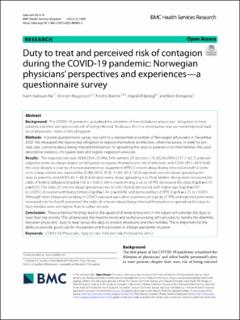| dc.contributor.author | Isaksson Rø, Karin Elisabet | |
| dc.contributor.author | Magelssen, Morten | |
| dc.contributor.author | Bååthe, Fredrik | |
| dc.contributor.author | Miljeteig, Ingrid | |
| dc.contributor.author | Bringedal, Berit | |
| dc.date.accessioned | 2023-01-03T13:05:04Z | |
| dc.date.available | 2023-01-03T13:05:04Z | |
| dc.date.created | 2022-12-22T10:06:21Z | |
| dc.date.issued | 2022 | |
| dc.identifier.issn | 1472-6963 | |
| dc.identifier.uri | https://hdl.handle.net/11250/3040668 | |
| dc.description.abstract | Background
The COVID-19 pandemic actualised the dilemma of how to balance physicians´ obligation to treat patients and their own perceived risk of being infected. To discuss this in a constructive way we need empirical studies of physicians´ views of this obligation.
Methods
A postal questionnaire survey was sent to a representative sample of Norwegian physicians in December 2020. We measured their perceived obligation to expose themselves to infection, when necessary, in order to provide care, concerns about being infected themselves, for spreading the virus to patients or to their families. We used descriptive statistics, chi-square tests and logistic regression analyses.
Results
The response rate was 1639/2316 (70.9%), 54% women. Of doctors < 70, 60,2% (95% CI 57.7–62.7) acknowledged to some or a large degree an obligation to expose themselves to risk of infection, and 42.0% (39.5–44.5) held this view despite a scarcity of personal protective equipment (PPE). Concern about being infected oneself to some or to a large extent was reported by 42.8% (40.3–45.3), 47.8% (45.3–50.3) reported concern about spreading the virus to patients, and 63.9% (61.5–66.3) indicated worry about spreading it to their families. Being older increased the odds of feeling obligated (ExpB = 1.02 p < 0.001), while experiencing scarcity of PPE decreased the odds (ExpB = 0.74, p = 0.01). The odds of concern about spreading virus to one´s family decreased with higher age (Exp B = 0.97, p < 0.001), increased with being female (Exp B = 1.44, p = 0.004), and perceived lack of PPE (Exp B = 2.25, p < 0.001). Although more physicians working in COVID-exposed specialties experienced scarcity of PPE and reported perceived increased risks for health personnel, the odds of concern about being infected themselves or spreading the virus to their families were not higher than for other doctors.
Conclusion
These empirical findings lead to the question if fewer physicians in the future will consider the duty to treat their top priority. This underscores the need to revisit and revitalise existing ethical codes to handle the dilemma between physicians´ duty to treat versus the duty to protect physicians and their families. This is important for the ability to provide good care for the patient and the provider in a future pandemic situation. | en_US |
| dc.language.iso | eng | en_US |
| dc.publisher | BMC | en_US |
| dc.rights | Navngivelse 4.0 Internasjonal | * |
| dc.rights.uri | http://creativecommons.org/licenses/by/4.0/deed.no | * |
| dc.title | Duty to treat and perceived risk of contagion during the COVID-19 pandemic: Norwegian physicians’ perspectives and experiences—a questionnaire survey | en_US |
| dc.type | Journal article | en_US |
| dc.type | Peer reviewed | en_US |
| dc.description.version | publishedVersion | en_US |
| dc.rights.holder | Copyright 2022 The Author(s) | en_US |
| dc.source.articlenumber | 1509 | en_US |
| cristin.ispublished | true | |
| cristin.fulltext | original | |
| cristin.qualitycode | 2 | |
| dc.identifier.doi | 10.1186/s12913-022-08905-3 | |
| dc.identifier.cristin | 2096795 | |
| dc.source.journal | BMC Health Services Research | en_US |
| dc.identifier.citation | BMC Health Services Research. 2022, 22, 1509. | en_US |
| dc.source.volume | 22 | en_US |

